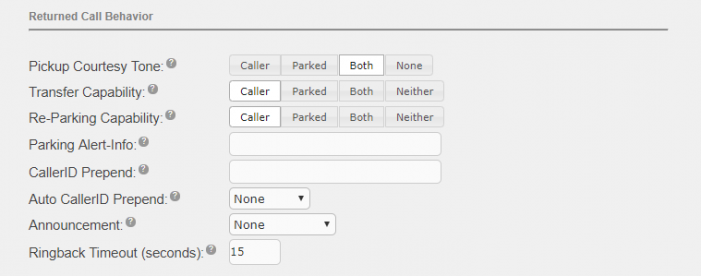Parking Lot
The Parking Lot or Call Park feature is used to put a call on hold in a shared space, then the call can be picked up later by any phone on the system.
For example, if the extension 700 is used to park a call, then while in a conversation you can park the call by pressing ## followed by 700. The system will announce the parking lot position (slot), the slot will be chosen by the system based on the configuration (example below slots are 701 - 704). Now hang up - the caller will be left on hold at the announced parking lot position. Walk up to a different phone, dial the slot number (e.g. 701) and you can pick up the parked call.
To manage the parameters and options for the Parking Lot feature, perform the following steps:
- Open the UCX Web-based Configuration Utility
- From the PBX tab, select PBX Configuration
- From the left side column, under Applications, select Parking Lot
- Enter the Parking Lot Extension number, this is the number you dial to park a call
-
The next two fields, Parking Lot Starting Position and Number of Slots configures the parking lot positions.
For example, if the Parking Lot Starting Position is 701 and the Number of Slots is 4, then the configured parking lot positions are 701, 702, 703 and 704. - The parking lot positions are listed in brackets after the Number of Slots field
-
The Parking Timeout field determines how long a call can stay in the parking lot before it times out

-
The fields under the section Returned Call Behavior determines the call behavior when a parked call is picked up and when the call is returned to the originator.

-
The fields under the section Alternate Destination determines where to send the caller when it times out waiting in the parking lot. The length of the timeout before routing to the Alternate destination is determined by the Ringback Timeout setting in the Returned Call Behavior section above.

Feature Code
An alternative method to pick up a call is to use the feature code *86. Instead of dialing the parked extension number, you can dial *86 to pick up the oldest parked call.
The feature code value is configured in the Feature Codes panel. The default value is *86.

Video Tutorial
Self Assessment Quiz
- What number do you dial to park a call?
- What number do you dial to retrieve a parked call?
- If the Blind Transfer feature is disabled on your UCX system, will the Parking Lot (or Call Park) feature work?


